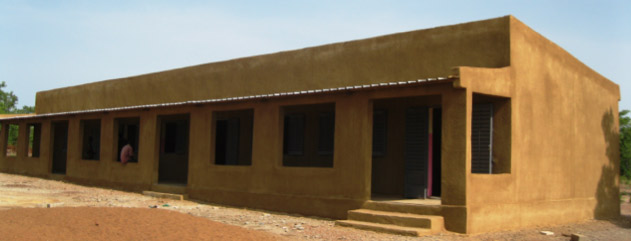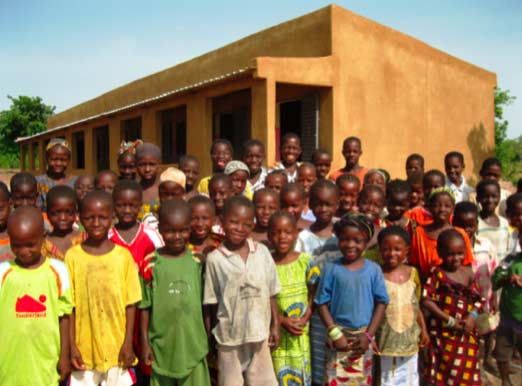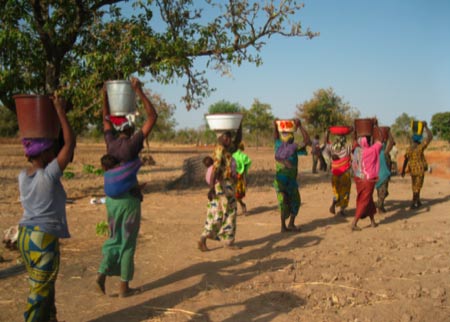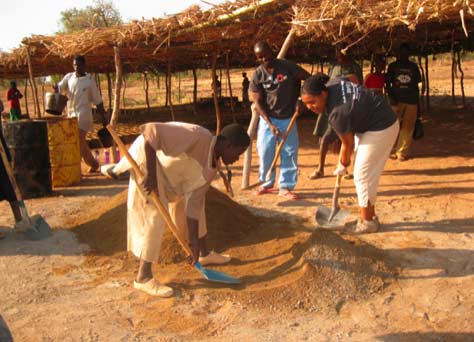The Bladie school was completed on May 3, 2011!
This school project broke ground on February 15th, 2011 and was completed on May 3rd, 2011. The people of Bladie contributed a total of 2,982 volunteer workdays to the project and finished 4 days ahead of schedule.

The new Bladie School

Inside a classroom

The Front Entrance
Bladie’s first permanent school block is constructed of cinderblocks, with a poured concreted floor and a corrugated tin roof. The finished school has 3 classrooms and 2 latrines. Students will begin studying in this school block in October at the start of the new school year.

Some of the school's student body
Community Member Comments
I would like to say thank you to buildOn, to our donors and to the Trek team for their hard work. This new school will reduce the illiteracy rate in our community. All the kids who couldn’t walk 3km because they are too little will now get education next to their parents. It is a big relief for parents to have their kids get an education in their village and be able to watch them. Both, parents and kids, will be very motivated. Even very little kids of 3 to 4 year old want to come to school now seeing this new building.
Seydou Samake, age 52, farmer and school committee member
During this project, we learned how good the materials need to be to have a very strong and long lasting school house. We learned how to well mix the cement and how good the ground must be to get a good foundation when digging. We learned the different stages of building with concrete for the first time.
Broulaye Samake, age 50, parent
What I have to say is a message of thanksgiving to our donors for their invaluable help, to buildOn and its staff for their hard work and good advices given to the population, and to anybody else who contributed to the donation of this nice building to the village of Bladie. May God reward all of them. We can’t thank them enough. This school opened my eyes and brought more motivation as far as education is concerned. We got more information about the importance of girls’ schooling, thanks to buildOn. buildOn did its share, and we promise to send all the school age children to class at the next recruitment. We think that this is the beginning of an eternal friendship between this community and buildOn. Aw n ice, Allah k’an to nyongon nye. (Thank you! May God keep our links strong forever!)
Samou N’fa Samake, age 41, school committee secretary
Bladie Community Profile
Bladie is located in Sikasso, the southern-most region in Mali. This village was founded 132 years ago by Faraban Samake. The people of Bladie belong to the Bambara ethnic group and practice the religion of Islam. There are 495 people living in Bladie in 26 family groups, and they are lead by the village chief, the Imam, the women’s representative, the youth representative and the school committee head. Bladie is about 75 km from the buildOn office in Bougouni and 98 km from the capital, Bamako.
The residents of Bladie are primarily farmers and livestock keepers. They grow millet, corn, beans, fonio, peanuts, sorghum and cotton. Some families are also beekeepers and produce honey to eat and sell. The women of the community produce shea butter, both to use themselves and to sell in the local market, which is 13 km away. The long and arduous task of making shea butter- collecting the shea nuts and then boiling, drying, peeling, pounding, boiling again, grinding, whisking, rinsing, and re-melting them- is done completely by hand.
The residents of Bladie are primarily farmers and livestock keepers. They grow millet, corn, beans, fonio, peanuts, sorghum and cotton. Some families are also beekeepers and produce honey to eat and sell. The women of the community produce shea butter, both to use themselves and to sell in the local market, which is 13 km away. The long and arduous task of making shea butter- collecting the shea nuts and then boiling, drying, peeling, pounding, boiling again, grinding, whisking, rinsing, and re-melting them- is done completely by hand.
Prior School Conditions
Prior to construction of the new school there were currently no classrooms in Bladie at all; the 27 students enrolled in school there (20 boys and 7 girls between the ages of 8 and 12) attend class in a community member’s home. These students are in grades 1-3 and all learn from the same teacher, who travels from Zantiebougou (105 km away) to teach them. Most of the children in Bladie are unable to go to school there and currently walk 3 km each day to attend classes in the nearby village of Zambougou. There are 113 children making this walk daily.
My hope for the future of this school is to have more rooms and to have government teachers to have the number of students grow a lot, namely the girls.
Ousmane Kone, teacher, 32 years old

Home previously used as a classroom
The Bladie School Project
Bladie’s first permanent school block was constructed of cinderblocks, with a poured concreted floor and a corrugated tin roof. The finished school will have 3 classrooms and 2 latrines, and was completed in early May 2011.

A trek team member breaks ground

Women carry water from the pump to the worksite for concrete

A Detroit Student and a community members mix concrete
This project broke ground on February 15th, 2011 with the help of a Trek for Knowledge team of 12 high school students and 1 teacher from buildOn’s after-school program in Detroit. These students were chosen from 8 different high schools and earned the opportunity to participate in the Trek after doing extensive local community service with buildOn. In Bladie they lived with host families, participated in cultural workshops, and worked side by side with community members for 10 days on the worksite.
Per buildOn methodology, they participated in the covenant signing ceremony with the community members and buildOn staff before breaking ground on the new school. This covenant outlines the plan for the project and the following commitments:
Community Contribution
• Unskilled labor: 30 workers (15 men and 15 women) per day, six days per week
• The land on which the school is built
• High quality local materials: sand, gravel,water & rocks
• Project management: a committee madeup of 12 villagers (six men, six women)
• Lodging for buildOn team: Field Coordinator and skilled laborers
• Basic construction tools (shovels, picks, wheelbarrows, buckets, etc.)
• Commitment to educating boys and girls equally
buildOn Contribution
• Construction materials (excluding local materials) for school and latrine
• Skilled labor and plans needed to build the school
• Project management (buildOn coordinators)
• Instruction in basic construction techniques
Per buildOn methodology, they participated in the covenant signing ceremony with the community members and buildOn staff before breaking ground on the new school. This covenant outlines the plan for the project and the following commitments:
Community Contribution
• Unskilled labor: 30 workers (15 men and 15 women) per day, six days per week
• The land on which the school is built
• High quality local materials: sand, gravel,water & rocks
• Project management: a committee madeup of 12 villagers (six men, six women)
• Lodging for buildOn team: Field Coordinator and skilled laborers
• Basic construction tools (shovels, picks, wheelbarrows, buckets, etc.)
• Commitment to educating boys and girls equally
buildOn Contribution
• Construction materials (excluding local materials) for school and latrine
• Skilled labor and plans needed to build the school
• Project management (buildOn coordinators)
• Instruction in basic construction techniques
